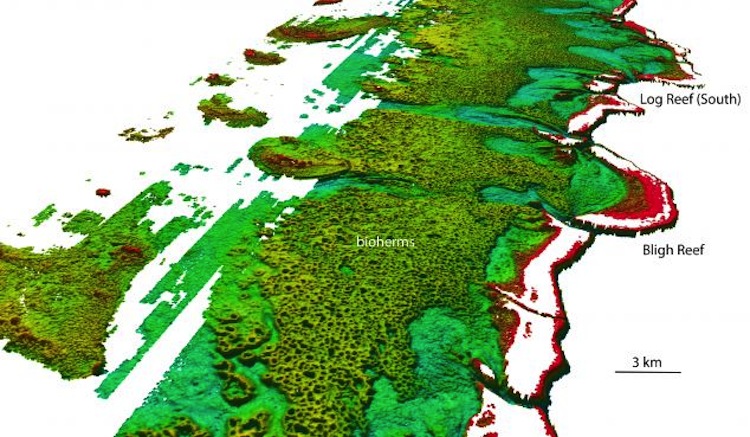Surprise! Another Massive Reef Is Hiding Behind the Great Barrier Reef

Behind Australia's iconic Great Barrier Reef hides another large, doughnut-shaped reef, according to a recent study.
Using laser data from the Royal Australian Navy, scientists found a large field of unusual circular mounds behind the familiar Great Barrier Reef. Upon further research, they discovered that the structures are Halimeda bioherms — geological formations created by green algae. [Images: Colorful Corals of the Deep Barrier Reef]
"We've known about these geological structures in the northern Great Barrier Reef since the 1970s and '80s, but never before has the true nature of their shape, size and vast scale been revealed," Robin Beaman, a research fellow at James Cook University in Australia and part of the team that discovered the reef, said in a statement.
The scientists called the discovery "vast," as they've mapped about 2,300 square miles (6,000 square kilometers) of the reef. Each doughnut-shaped mound measures 650 to 980 feet (200 to 300 meters) across and up to 33 feet (10 m) deep at the center.
The structures form "a significant inter-reef habitat" covering a greater area than nearby coral reefs, said Mardi McNeil, lead author of the new study and a marine geoscience research student at the Queensland University of Technology.
This bioherm field raises questions about the effects of climate change and the reef's vulnerability, because Halimeda may be susceptible to ocean acidification and warming, the scientists said. Warmer ocean temperatures cause coral bleaching — a phenomenon that occurs when coral are stressed by the warmer-than-average waters,. This causes the coral to expel the algae that live in them, which can be fatal to the reef if bleaching continues for too long and algae are unable to recolonize. Earlier this year, Australia's National Coral Bleaching Taskforce (NCBT)announced that more than 90 percent of the Great Barrier Reef shows signs of bleaching, which has been accelerated by record heat this year.
Further study of the new reef could offer new avenues of research into the impact of climate change and coral bleaching, Beaman said.
Sign up for the Live Science daily newsletter now
Get the world’s most fascinating discoveries delivered straight to your inbox.
"For instance, what do the 10- to 20-meter-thick [33 to 66 feet] sediments of the bioherms tell us about past climate and environmental change on the Great Barrier Reef over this 10,000-year timescale?" he said. "And what is the finer-scale pattern of modern marine life found within and around the bioherms now that we understand their true shape?"
Similar to the rings of a tree, coral rings can offer scientists information about the age of the coral and the environment in which it formed. Beaman added that further research of the site would include taking sediment samples and continuing more detailed surveys of the area. The research team will also use autonomous underwater vehicles to investigate the physical, chemical and biological processes of the structures.
The study was published online Aug. 24 in the journal Coral Reefs.
Original article on Live Science.











